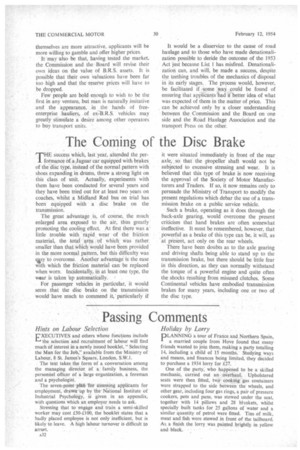The Coming of the Disc Brake
Page 34

If you've noticed an error in this article please click here to report it so we can fix it.
THE success which, last year, attended the perfotmance of ajaguar car equipped with brakes of the disc type, instead of the normal pattern with shoes expanding in drums, threw a strong light on this class of unit. Actually, experiments with them have been conducted for several years and they have been tried out for at least two years on coaches, whilst a Midland Red bus on trial has been equipped with a disc brake on the transmission.
The great advantage is, of course, the much enlarged area exposed to the air, thus greatly promoting the cooling effect. At first there was alittle trouble with rapid. wear •of the friction material, the total area of which was rather smaller than that which would have been provided in the more normal pattern, but this difficulty was cisy to overcome. Another advantage is the ease with which the friction material can be replaced when worn. Incidentally, in at least one type, the wear is taken up automatically.
For passenger vehicles in particular, it would seem that the disc brake on the transmission would have much to commend it, particularly if it were situated immediately in front of the rear . axle, so that the propeller shaft would not be subjected to excessive stressing and wear. It is believed that this type of brake is now receiving the approval of the Society of Motor Manufacturers and Traders. If so, it now remains only to persuade the Ministry of Transport to modify the present regulations which debar the use of a transmission brake on a public service vehicle.
Such a brake, operating as it does through the back-axle gearing, would overcome the present criticism that hand brakes are often somewhat ineffective. It must be remembered, however, that powerful as a brake of this type can be, it will, as at present, act only on the rear wheels.
There have been doubts as to the axle gearing and driving shafts being able to stand up to the transmission brake, but there should be little fear in this direction, as they can normally withstand the torque of a powerful engine and quite often the shocks resulting from misused clutches. Some Continental vehicles have embodied transmission brakes for many years, including one or two of the disc type.




































































































